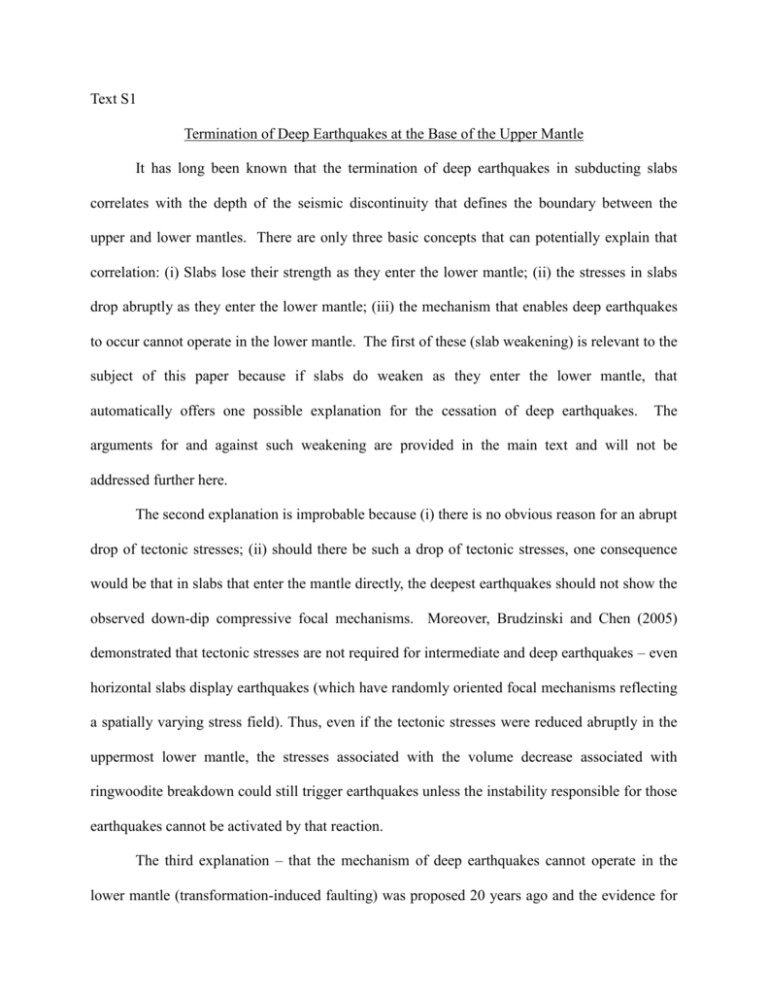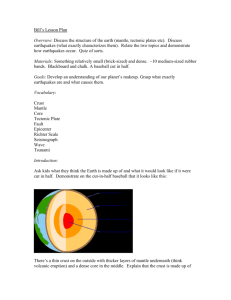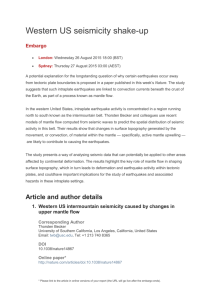grl29187-sup-0002-txts01
advertisement

Text S1 Termination of Deep Earthquakes at the Base of the Upper Mantle It has long been known that the termination of deep earthquakes in subducting slabs correlates with the depth of the seismic discontinuity that defines the boundary between the upper and lower mantles. There are only three basic concepts that can potentially explain that correlation: (i) Slabs lose their strength as they enter the lower mantle; (ii) the stresses in slabs drop abruptly as they enter the lower mantle; (iii) the mechanism that enables deep earthquakes to occur cannot operate in the lower mantle. The first of these (slab weakening) is relevant to the subject of this paper because if slabs do weaken as they enter the lower mantle, that automatically offers one possible explanation for the cessation of deep earthquakes. The arguments for and against such weakening are provided in the main text and will not be addressed further here. The second explanation is improbable because (i) there is no obvious reason for an abrupt drop of tectonic stresses; (ii) should there be such a drop of tectonic stresses, one consequence would be that in slabs that enter the mantle directly, the deepest earthquakes should not show the observed down-dip compressive focal mechanisms. Moreover, Brudzinski and Chen (2005) demonstrated that tectonic stresses are not required for intermediate and deep earthquakes – even horizontal slabs display earthquakes (which have randomly oriented focal mechanisms reflecting a spatially varying stress field). Thus, even if the tectonic stresses were reduced abruptly in the uppermost lower mantle, the stresses associated with the volume decrease associated with ringwoodite breakdown could still trigger earthquakes unless the instability responsible for those earthquakes cannot be activated by that reaction. The third explanation – that the mechanism of deep earthquakes cannot operate in the lower mantle (transformation-induced faulting) was proposed 20 years ago and the evidence for that explanation has grown steadily since that time. A brief summary is presented here only to make clear that termination of deep earthquakes is not an independent argument one can make to argue that slabs weaken as they enter the lower mantle. It was suggested in the 1970s that subducting slabs could be so cold that olivine might be carried metastably into the mantle transition zone (MTZ) (Sung and Burns, 1976). Experimental data later provided observations that such could be the case and that deep earthquakes in subducting slabs could be triggered by a shearing instability accompanying the phase transformations from olivine to its high-pressure polymorphs [e.g. Green and Burnley, 1989; Green et al., 1990; Green and Houston, 1995; Green, 2007]. That instability, however, cannot operate during the endothermic ringwoodite break-down reaction that defines the bottom of the upper mantle (Green and Zhou, 1996; Gleason and Green, 2009). The mineral reactions from olivine to a modified spinel structure (wadsleyite) or to a true spinel (ringwoodite) are exothermic polymorphic transformations – one phase changes to another phase of the same composition but different structure with release of heat – whereas the breakdown of ringwoodite at the base of the MTZ involves endothermic decomposition of a single parent phase into two daughter phases, one with a perovskite structure and the other an oxide. (Mg,Fe)2SiO4 → (Mg,Fe)SiO3 + (Mg,Fe)O spinel perovskite (S1) oxide Because the phase transformations from olivine to wadsleyite or ringwoodite are exothermic and polymorphic [Vaughan and Coe, 1981; Green and Houston, 1995; Green, 2007], under certain conditions they can lead to latent-heat-driven runaway nucleation of the stable phase and consequently, through a complicated process, develop a shearing instability that in subduction zones could provide the explanation for deep earthquakes [Green and Burnley, 1989; Green et al., 1990; Green and Houston, 1995; Kirby et al., 1996]. In contrast, the breakdown reaction (S1) yields two daughter phases; such reactions cannot support such a reaction-triggered instability whether or not it is exothermic [Gleason and Green, 2009] and therefore could be the reason for termination of earthquakes at the base of the MTZ. Metastable olivine has now been observed seismically in four deep slabs [Iidaka and Suetsugu, 1992; Chen and Brudzinski, 2001; Kaneshima et al., 2007; Jiang et al., 2008; Kawakatsu and Yoshioka, 2011], providing strong support for this deep earthquake mechanism and implying that slabs are very cold and essentially dry below 400 km [Green et al., 2010; Kawakatsu and Yoshioka, 2011]; such observations also suggest that cold slabs are strong. Runaway shear heating has also been suggested as a mechanism for deep earthquakes [e.g. Karato et al., 2001] but that mechanism in and of itself cannot explain cessation of deep earthquakes at the base of the upper mantle because there is no intrinsic reason for that mechanism to be active in the transition zone but impossible in the lower mantle. Moreover, the discovery of significant amounts of metastable olivine in multiple cold slabs during the last 10 years undermines many of the assumptions upon which the hypothesis of earthquakes by runaway shear heating has been based (see also Green, 2003). If follows from this discussion that cessation of earthquakes cannot be used as an argument for slab weakening during entry into the lower mantle. The arguments for strength of slabs must stand on their own merits.









